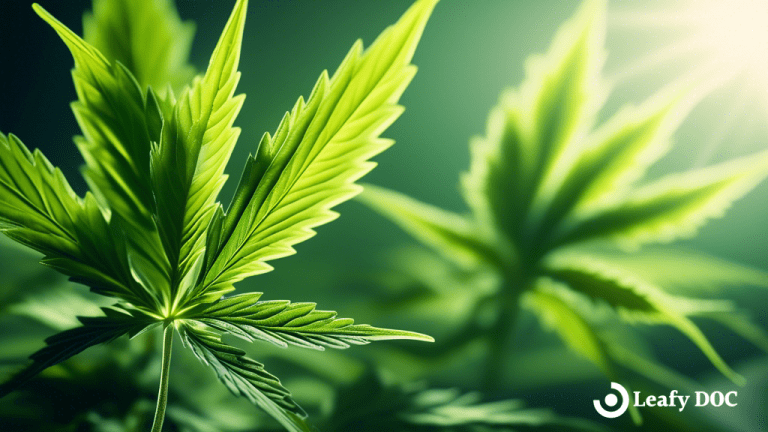Master Cooking with Weed: Essential Steps for Beginners
by Maya Green · May 6, 2025
Unlock the art of cooking with weed and explore delicious cannabis-infused recipes.

Overview
The article “Master Cooking with Weed: Essential Steps for Beginners” serves as a compassionate guide for those just starting their journey with cannabis cooking. It recognizes that many beginners may feel overwhelmed and emphasizes the importance of understanding:
- Cannabis strains
- Cannabinoids
- The decarboxylation process
to help maximize potency. This foundational knowledge is crucial for ensuring safe and enjoyable consumption.
You may find that the article provides essential recipes and dosage calculations, which are designed to support you in your cooking endeavors. By breaking down these concepts into manageable steps, the article aims to empower you with the confidence to explore the culinary possibilities of cannabis. Remember, cooking with cannabis can be a rewarding experience when approached with care and understanding.
Ultimately, this article encourages you to embrace your curiosity and take actionable steps towards mastering the art of cooking with cannabis. With the right knowledge and support, you can create delightful dishes that enhance your enjoyment and wellness.
Introduction
In recent years, the culinary world has experienced a remarkable transformation, as cannabis takes center stage in kitchens around the globe. This article invites you to explore the art of cannabis-infused cooking, offering a comprehensive guide tailored for both novice and seasoned cooks. Together, we will uncover the myriad possibilities this versatile ingredient presents.
As you embark on this journey, it’s essential to understand the basics of cannabis strains and cannabinoids. You may find that mastering techniques like decarboxylation and creating infused ingredients such as cannabutter and cannaoil can elevate your culinary creations to new heights. Remember, this exploration is not just about cooking; it’s about unlocking new flavors and experiences that can enrich your life.
With a focus on safety and dosage, along with a selection of delicious recipes, this culinary journey aims to make the world of cannabis cooking accessible and enjoyable for everyone. So, let’s dive in together and discover how cannabis can transform your kitchen into a space of creativity and joy.
Understand Cannabis Basics for Cooking
Before diving into cooking with weed, it’s important to understand some foundational elements that can enhance your culinary journey and overall experience.
Cannabis Strains: Cannabis is categorized into three primary types: Sativa, Indica, and Hybrid. Sativa strains are typically uplifting and energizing, making them ideal for daytime use. On the other hand, Indica strains are known for their relaxing effects, suitable for evening consumption. Hybrids blend characteristics from both, offering a balanced experience tailored to individual preferences. You may find it interesting that approximately 60% of marijuana users prefer Sativa strains, while 40% lean towards Indica, reflecting the diverse preferences in culinary applications.
Cannabinoids: The two most prominent cannabinoids are THC (tetrahydrocannabinol) and CBD (cannabidiol). THC is the psychoactive element that generates the ‘high’ linked to marijuana, while CBD is non-psychoactive and is frequently employed for its therapeutic advantages, such as pain alleviation and anxiety relief. Understanding these differences can help you choose the right strain for your needs.
Terpenes: These aromatic compounds are responsible for the distinct flavors and scents of various strains of marijuana. Beyond their sensory contributions, terpenes may also influence the overall effects of cannabis, enhancing or altering the experience depending on the strain utilized. It’s important to remember that these elements work together to create a unique experience for each individual.
Consumption Methods: Familiarize yourself with various consumption methods, including smoking, vaping, and edibles. Each method has distinct impacts on the body, especially concerning onset time and duration. For example, when cooking with weed, edibles may require more time to start working but frequently offer a more extended influence, making them a favored option for numerous users.
Cannabis-Infused Sweetener: Understanding how to infuse sweetener with cannabis is crucial for creating delicious and effective cannabis-infused dishes. This versatile component not only enhances taste but also provides healing benefits, making it an excellent option for both wellness and culinary uses. Whether you choose to utilize CBD syrup for relaxation or THC-infused syrup for amplified effects, this infusion offers a smoke-free method to enjoy cannabinoids. You can effortlessly blend marijuana-infused honey into teas, baked items, salad dressings, and marinades while cooking with weed, providing a distinctive culinary experience. Grasping these ideas will empower you to craft tasty and effective dishes through cooking with weed. Embrace this journey of cooking with weed, and you’ll find that it can significantly enhance your culinary skills while maximizing the benefits of marijuana.
Decarboxylate Cannabis for Maximum Potency
To decarboxylate the herb effectively and maximize its potency for cooking, it’s essential to follow these steps with care:
- Preheat Your Oven: Set your oven to 240°F (115°C).
- Prepare the Herb: Gently break up your buds into smaller pieces and spread them evenly on a baking sheet lined with parchment paper.
- Bake: Place the baking sheet in the oven and bake for 30-40 minutes. Remember to stir the herb every 10 minutes to ensure even heating.
- Cool Down: Once done, remove the cannabis from the oven and let it cool. It should look a bit brown and dry, signaling that the process has worked well.
This decarboxylation process is crucial as it transforms THCA (tetrahydrocannabinolic acid) into THC, the compound responsible for the psychoactive properties, preparing it for your adventures in cooking with weed. Without proper decarboxylation, products infused with cannabis may have minimal effects, which could limit their therapeutic benefits. Research indicates that effective decarboxylation significantly enhances the effectiveness of marijuana for cooking with weed, ensuring that you can fully realize its therapeutic benefits.
As marijuana use continues to gain acceptance, many industry leaders recommend this method as a best practice. They underscore the importance of decarboxylation in cooking with weed to achieve the desired outcomes in cannabis-infused dishes. Furthermore, understanding the potency of your cannabis-infused olive oil is essential; the strength depends on the type of herb used and the quality of the olive oil. Extra virgin olive oil is often recommended for its healthy fats and rich flavor, which can enhance the overall effectiveness of your infused products.
Ongoing research by coordinators collecting data on dosing strategies and therapeutic outcomes reinforces the significance of adhering to best practices in this field, ensuring that you can make informed choices for your health and well-being.
Make Infused Ingredients: Cannabutter and Cannaoil
Creating cannabutter can be a rewarding experience, and it’s essential to approach it with care. Here are some simple steps to guide you:
- Ingredients: Gather 1 cup of unsalted butter, 1 cup of water, and your decarboxylated herb.
- Melt the Butter: In a saucepan, combine the butter and water over low heat until fully melted. It’s important to take your time with this step.
- Add Cannabis: Stir in the decarboxylated cannabis, maintaining low heat for 2-3 hours. Remember to stir occasionally to ensure even infusion; this is where the magic happens.
- Strain: After simmering, strain the mixture through a cheesecloth into a container, discarding the plant material. Allow it to cool and solidify in the refrigerator, and enjoy the anticipation of your creation.
If you’re interested in cannaoil, simply substitute oil for butter and follow the same steps. This versatile oil can enhance a variety of dishes, from salad dressings to baked goods, inviting you to explore new culinary possibilities.
Cannabutter and cannaoil have gained popularity, becoming essential components in many recipes for cooking with weed. Chefs emphasize the importance of creativity in cooking. As Wolfgang Puck noted, “Cooking is like painting or writing a song. Just as there are only so many notes or colors, there are only so many flavors – it’s how you combine them that sets you apart.” This highlights the artistic aspect of using infused ingredients, allowing for unique culinary experiences that can bring joy and satisfaction.
Moreover, cooking can be a treasure worth more than gold when done with family, creating cherished memories while exploring new flavors together. You may find that recent trends indicate an increasing interest in cooking with weed, as many home cooks are experimenting with these cannabis-based ingredients. By mastering the art of cooking with weed, specifically through making cannabutter and cannaoil, you can elevate your cooking and delve into a new realm of flavors that nurture the soul.
Additionally, cannabis-infused syrup offers a smoke-free way to enjoy cannabinoids, providing therapeutic benefits such as pain relief and relaxation. This honey can be easily incorporated into various recipes, enhancing both flavor and wellness effects. Leafy DOC connects patients with licensed healthcare professionals through an online telehealth service, ensuring that those in need have access to cannabis-related resources and support. This accessibility is crucial for chronic pain patients seeking to enhance their culinary experiences with marijuana, and it’s heartwarming to know that help is available.
Calculate Dosage and Ensure Safe Consumption
Calculating your dosage effectively is crucial for a safe and enjoyable experience with cannabis-infused products.
- Know Your Marijuana: It’s essential to identify the THC percentage in your marijuana. For example, if you have 1 gram of cannabis with 20% THC, it contains 200 mg of THC. Understanding this helps you make informed choices.
- Choose the Recipe: When preparing olive oil with cannabis, consider how much you’ll use in your dishes. If you mix 1 cup of olive oil infused with cannabis containing 200 mg of THC into a batch of brownies, remember to divide that total by the number of servings. This ensures you can manage your intake wisely.
- Serving Size: If your recipe yields 12 brownies, each would contain approximately 16.67 mg of THC. It’s wise to start with a small portion to assess your tolerance. You may find that starting low helps you feel more comfortable as you explore.
- Start Low, Go Slow: For those new to edibles, beginning with a low dose is a gentle approach. Wait at least 1-2 hours before consuming more, as the effects can take time to manifest. A less experienced user may only take a milligram or two of THC and have a relatively mild and shorter-lived experience. Remember, it’s all about finding what works best for you.
Accurate dosage calculation is essential for enjoying cannabis-infused products safely. Keep in mind that cannabinoids can settle unevenly in olive oil infused with cannabis, affecting dosage accuracy. By following these guidelines, you can enhance your cooking with weed experience while ensuring safe consumption. You deserve to enjoy your culinary creations with confidence and peace of mind.
Explore Delicious Cannabis-Infused Recipes
Explore Delicious Cannabis-Infused Recipes
Discover a variety of delicious cannabis-infused recipes that are perfect for beginners looking to explore the culinary possibilities of cannabis. You may find joy in trying these delightful options:
- Cannabis-Infused Brownies: Enhance a traditional dessert by adding cannabutter to your brownie mixture. This results in a delightful treat that harmonizes taste and experience. Consider using cannabis-infused syrup for a unique twist, enhancing both flavor and therapeutic benefits.
- Canna-Olive Oil Pasta: For a quick and flavorful dish, toss cooked pasta with cannaolive oil, garlic, and fresh herbs. This allows the infused oil to elevate the overall taste. You might also drizzle infused syrup over the dish for added sweetness and wellness benefits.
- Cannabis-Infused Salad Dressing: Mix cannaolive oil with balsamic vinegar, mustard, and infused syrup to create a distinctive salad dressing. This adds a delightful twist to your greens while offering the anti-inflammatory benefits of both syrup and the infused oil.
- Canna-Tea: For a soothing drink, steep your favorite tea with a teaspoon of infused syrup. This offers a calming experience with every sip, allowing you to enjoy the soothing effects of CBD or THC while savoring the natural sweetness.
How to Infuse Sweetener with Marijuana: To create marijuana-infused sweetener, start by decarboxylating your marijuana flowers to activate the THC and CBD. Preheat your oven to 240°F (115°C), grind the plant material, and bake it on a parchment-lined sheet for 30-40 minutes. Then, combine 3.5 grams of decarbed marijuana with one cup of raw honey in a slow cooker on low heat for 4-6 hours, stirring occasionally. Strain the mixture through cheesecloth to remove plant material and store it in a cool, dark place.
These recipes serve as a wonderful base for your culinary journey with marijuana. Don’t hesitate to experiment with infused ingredients across a range of dishes, from savory to sweet, as the possibilities are truly endless. As chef Noah Tucker notes, “What’s that extra little bump that this ingredient gives?” This exploration of flavors is part of the growing trend of marijuana dining experiences, particularly in areas like San Francisco, which is undergoing a ‘green rush.’ Home cooks are increasingly embracing the art of cannabis-infused cooking, leading to innovative and enjoyable dining experiences. Feedback from guests at events like ‘High Cuisine’ highlights the positive experiences associated with these meals, with one guest expressing, ‘I’m as high as a helicopter.’ Embrace this culinary journey and discover the unique flavors and effects that cannabis can bring to your cooking.
Conclusion
Embarking on a journey into cannabis-infused cooking unveils a delightful world of flavors, creativity, and wellness, enriching any culinary experience. By understanding the basics of cannabis—like the various strains, cannabinoids, and terpenes—you lay a strong foundation for cooking with this versatile ingredient. It’s essential to master proper techniques, such as decarboxylation, to unlock the full potency of cannabis, ensuring that its therapeutic benefits shine in every dish.
Creating infused ingredients like cannabutter and cannaoil opens a realm of possibilities in your kitchen. These staples not only elevate traditional recipes but also inspire experimentation, encouraging you to craft unique dishes that harmonize taste and effect. Remember, prioritizing safety and accurately calculating dosages is crucial for anyone venturing into cannabis cooking, ensuring a responsible and enjoyable experience.
As the culinary landscape evolves, embracing cannabis in cooking transcends novelty; it invites you to explore new dimensions of flavor and well-being. With a wealth of delicious recipes—from cannabis-infused brownies to canna-olive oil pasta—the possibilities are limited only by your imagination. This culinary adventure warmly invites you to discover the joys and benefits of cannabis cooking, transforming your kitchen into a space of creativity, connection, and joy.
Frequently Asked Questions
What are the main types of cannabis strains and their effects?
The three primary types of cannabis strains are Sativa, Indica, and Hybrid. Sativa strains are uplifting and energizing, ideal for daytime use. Indica strains are relaxing and suitable for evening consumption. Hybrid strains combine characteristics of both, offering a balanced experience.
What are cannabinoids and their significance in cooking with weed?
The two most prominent cannabinoids are THC (tetrahydrocannabinol) and CBD (cannabidiol). THC is psychoactive and produces the ‘high’ associated with marijuana, while CBD is non-psychoactive and is often used for therapeutic benefits like pain relief and anxiety reduction. Understanding these cannabinoids helps in selecting the right strain for cooking.
What role do terpenes play in cannabis?
Terpenes are aromatic compounds that contribute to the distinct flavors and scents of various cannabis strains. They may also influence the overall effects of cannabis, enhancing or altering the experience depending on the strain used.
What are the different methods of consuming cannabis?
Common consumption methods include smoking, vaping, and edibles. Each method affects the body differently, particularly in terms of onset time and duration. Edibles may take longer to take effect but often provide a longer-lasting influence.
How can I infuse sweeteners with cannabis for cooking?
Infusing sweeteners with cannabis is key for creating delicious cannabis-infused dishes. This can be done using CBD syrup for relaxation or THC-infused syrup for stronger effects. Cannabis-infused honey can be blended into various recipes, enhancing flavor and providing therapeutic benefits.
What is the decarboxylation process and why is it important?
Decarboxylation is a process that transforms THCA into THC, maximizing the potency of cannabis for cooking. This involves preheating the oven, preparing the herb, baking it for 30-40 minutes, and allowing it to cool. Proper decarboxylation is crucial for ensuring that cannabis-infused products have the desired effects.
How should I prepare cannabis-infused olive oil?
The potency of cannabis-infused olive oil depends on the type of herb used and the quality of the olive oil. Extra virgin olive oil is recommended for its healthy fats and rich flavor, which can enhance the effectiveness of the infused products.
What is the significance of adhering to best practices in cooking with cannabis?
Following best practices, such as proper decarboxylation and understanding dosing strategies, ensures that you can make informed choices for health and well-being, enhancing the therapeutic benefits of cannabis in your cooking.
Last Updated: July 12, 2025
Get Approved for Your Medical Marijuana Card in Minutes!

Get Your Medical Card
Connect with a licensed physician online in minutes

Like This Article?
Share with your friends
Table of Contents
Keep Reading
-
Understanding The Impact Of Cannabis Legalization: Insights And Analysis
Uncover the real impact of cannabis legalization with our insightful analysis. Discover the truth behind the buzz and gain a deeper understanding of this important issue. Click here to learn more!
-
What To Expect During A Medical Marijuana Card Evaluation
Unlock the benefits of medical marijuana with our comprehensive guide. Learn about the process and qualifications for a medical marijuana card evaluation, taking your first step towards natural relief today!
-
Reducing Inflammation With Terpenes In Cannabis
Discover how cannabis terpenes can naturally reduce inflammation and improve your health. Click now to learn more about the healing benefits of terpenes!






